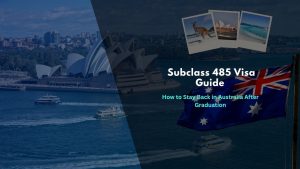How to Choose the Right Course to Get PR in Australia
Australia has long been a dream destination for students, professionals, and families seeking a better quality of life. But securing permanent residency (PR) takes more than just a desire to move — it takes strategy. A friend of mine, Raj, moved as a student, worked smartly toward his PR, and today enjoys the stability and security that come with it. This guide will help you understand how to take PR in Australia, from points to courses and beyond.
What is PR and Why Does It Matter?
PR allows you to live, work, and study in Australia indefinitely. It gives you access to Medicare, social benefits, and the opportunity to apply for citizenship later. For many, PR means freedom — no visa renewals, no uncertainty, just a future in Australia.

Pathways to PR in Australia
There’s no one-size-fits-all. Here are the main routes:
- Skilled migration: If your job is on the skilled occupation list, you can apply independently.
- Employer-sponsored visas: If you have a job offer, your employer might sponsor your PR.
- Family/partner visas: Available if you have close family or a partner who is a citizen or PR holder.
- Business/investor visas: For those bringing funds or business skills to Australia.
Criteria for PR in Australia
You’re assessed on several factors:
- Age: Ideal age is under 33 for maximum points.
- English proficiency: Prove your skills with IELTS, PTE or similar tests.
- Work experience: Both Australian and overseas experience count.
- Qualifications: Australian qualifications give an edge.
- Health and character: Mandatory checks for all applicants.
How the PR Points System Works
The skilled migration PR process uses a points system. You need at least 65 points, but higher scores (85+) improve your chances.
Example points:
- Age 25-32: 30 points
- Superior English: 20 points
- 8+ years skilled work overseas: 15 points
- Australian study: 5-10 points
- Regional study: 5 points
- Partner skills: up to 10 points
Boosting Your PR Points
Here’s what worked for Raj and many others:
- Improve English test scores: Retaking PTE or IELTS can gain you 10-20 points.
- Regional nomination: Adds points and speeds up invitations.
- Study PR-aligned courses: Certain qualifications are in high demand.
PR Courses in Australia That Help
While there’s no official “PR courses in Australia,” certain fields align with in-demand jobs:
- Nursing
- Civil, mechanical, or electrical engineering
- IT (including cybersecurity and software development)
- Early childhood education
- Trades (plumbing, carpentry)
These courses often appear on the Medium and Long-term Strategic Skills List (MLTSSL), boosting eligibility.
Choosing the Right PR Course
Don’t pick a course solely for PR points. Align it with your interests and strengths. I’ve seen people burn out because they chose a field they didn’t enjoy, thinking it would make PR easier. One client, for example, moved from marketing to IT, completed a cybersecurity course, and secured employer sponsorship within a year of graduating.
Applying for PR: The Steps
The general process:
- Skills assessment by a recognized authority.
- English test (IELTS, PTE).
- Expression of Interest (EOI) submission via SkillSelect.
- Receive invitation to apply.
- Lodge PR application with documents.
- Health and police checks.
Incomplete or incorrect documents often delay or derail applications — double-check everything.
Costs and Timelines
Expect costs like:
- Skills assessment: $ 1000- $ 5000
- English test: $ 400-500
- Visa fee: AUD 4,640+
- Medical and police checks: AUD 400+
Processing usually takes 6 to 12 months after the invitation.
Common Challenges
- Low points: Improve English, gain more experience, or consider regional options.
- No job offer: State or regional nomination can help.
- Visa refusals: Understand the reason and reapply strategically.
Life After PR
PR gives you freedom to live and work anywhere, access Medicare, sponsor family, and apply for citizenship after meeting residency requirements. But it also comes with responsibilities like paying taxes and following Australian laws.
Conclusion
Getting PR in Australia is not easy, but with careful planning and persistence, it’s achievable. Whether you choose a bustling city or a quieter regional area, the key is to align your plan with your skills, interests, and long-term goals. So, where would you start your PR journey?
FAQs
What is the minimum PR points in Australia in 2025?
65 points, but most invitations go to applicants with 85 or higher.
Which courses help with PR in Australia?
Nursing, engineering, IT, early childhood education, and trades are popular choices aligned with demand.
Can I get PR without a job offer?
Yes, through skilled migration if you meet points requirements and your occupation is on the list.
How long does PR processing take?
Typically 6 to 12 months after applying, depending on your case.How can I improve my PR points?
Improve your English test score, apply for regional nomination, or gain additional qualifications.






